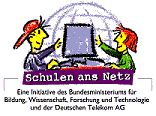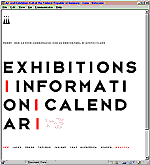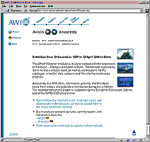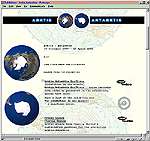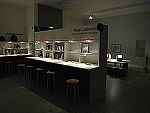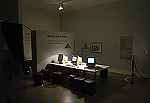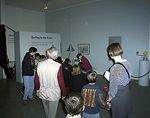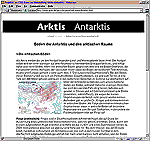 |
|
|
|
Archives & Museum Informatics info @ archimuse.com www.archimuse.com |

School and Museum on the NetNorbert Kanter, Kunst- und Ausstellungshalle der Bundesrepublik Deutschland"School and Museum on the net" is a cooperative educational project between the highschool Clara-Schumann-Gymnasium and the Kunst- und Ausstellungshalle der Bundesrepublik Deutschland in Bonn (Art and Exhibition Hall of the Federal Republic of Germany) and part of the national initiative "Schulen ans Netz". It was developed within the context of the exhibition "Arktis-Antarktis" ("Arctic-Antarctica", 12/19/1997 - 04/19/1998), a lively presented exhibition with over 600 displayed objects in a gallery space of 2.000 m2, covering art and cultural history as well as discovery and exploration of the north and south polar regions. Its goal was to learn about the impact of new media and communication contexts for education. The paper presents the genesis of the project, its planning, implementation and achievements with the involvment of students, teachers and museum education and new media departments. 1. "Schulen ans Netz",
the broader setting of the project
1. "Schulen ans Netz", the broader setting of the project ( back ) "Schulen ans Netz" ("Schools to the net!") is an initiative of the German government in cooperation with the German Telekom. The aim of this unprecendented "public private partnership", which took off in early '96, is to provide to all highschool students the means to make creative use of networked information systems and multimedia as "... sensemaking valuable acquisition instead of a 'media shower'." (Federal Minister Dr. Jürgen Rüttgers, statement on the occasion of the launch of "Schulen ans Netz", 04/18/1996, Bonn). Starting from the classrooms, this initative is a first step towards the acquisition of skills that will enable students and teachers to meet with the challenges of the information society and can be summarized by the following activities:
Furthermore "Schulen ans Netz" deals with "media literacy", "media competence" for students, the use of internet and multimedia as addendum to learning content, the broadening of the means of traditional learning and teaching methods. Despite the fact that Germany possesses the most advanced ISDN infrastructure and fibre optics network worldwide (statement of the German Telekom), in matters of new media design and use for education and training the advancements were not considerable until now. The project partners decided to connect 10.000 highschools to the internet within three years and collected for this a budget of 60 million DM. Consequently approximately a quarter of all German schools (44.000 in total) were able to receive at least one computer and an ISDN internet connection to the Deutsches Forschungsnetzwerk (DFN) (German Science Network, internet provider for universities). The number of connection points to the Wissenschaftsnetz (Science Network) should be increased in order to assure low telephone line costs (unfortunately the German Telekom could not afford unlimited free internet connection for all the schools). The association "Schulen ans Netz" was founded in order to manage and administrate the project. A web site was created for the diffusion of the project reports and latest news and developments. In addition to this "national equipment initiative" which constitutes the "entry level", schools have also the possibility to develop their own proposals, the so-called "model projects". The "model project" can go beyond the basic computer and software equipment by creating a sophisticated and "media appropriate" concept for "new learning and teaching". It is also possible to include other partners into this proposal. Besides the main sponsors - BMBF (Federal minister of Education, Science, Research and Technology) and Deutsche Telekom - Apple Computer Deutschland, the german magazine STERN as well as about 30 more sponsors (computer companies, publishers, internet providers etc.) contributed significantly to "Schulen ans Netz". Today these efforts increased up to 6.500 the number of schools with an internet connection (compared to only 500 in the beginning of "Schulen ans Netz"). More than 200 "model projects" were sponsored and more than a 1.000 courses for teacher's training took place - last but not least: more than 1.700 schools created their own homepage on the net. Although the project was initially planned to run on a three year period, the partners have already agreed on its extension. Until the year 2000 10.000 more schools should be connected to the net through "Schulen ans Netz". 2. The partners of "School and Museum on the net" ( back ) |
||||
|
During autumn '96, teachers from the Clara-Schumann-Gymnasium and representatives of the Kunst- und Ausstellungshalle discussed for the first time the possibilities to combine exhibition content, museum education and curriculum in order to propose a "model projekt" for the "Schulen ans Netz" initiative. The forthcoming exhibition "Arktis-Antarktis", scheduled to open in december '97, could provide a perfect setting for the synthesis of educational work within an exhibition and in connection with the work in classrooms. Two teachers from the school were appointed "project managers", while at the Kunst- und Ausstellungshalle the head of the education department and the project manager for new media were in charge of the new project. Together we have worked on the "raw concept" of content and technology. In november '96 our joint proposal was delivered to "Schulen ans Netz". This kind of cooperation, between a highschool and a museum / exhibition hall, was at that time completely new in Germany - and still remains. However, the very good overall circumstances contributed to the launching of such a collaboration. Since 1990 the Kunsthalle worked extensively with computer, databases and networked applications, while since '96 the activities in the field of new media increased (web site online since 4th of july '96!). Within the Clara-Schumann-Gymnasium committed teachers and enthousiastic students have shown a strong will to experiment with new means of learning interaction (students ages ranging from 11 to 19 years old).
In addition to the favourable circumstances, the quality of the proposal was supported by the various skills and experiences of all the people involved. Education and computer specialists, exhibition curators as well as the exhibition designer participated actively and contributed to the "shaping" of the concept. The 12-month time span available for preparing the project helped to guarantee the quality of the planning. In the beginning of '97 the partners received the unofficial message from "Schulen ans Netz" according to which the project proposal "School and Museum on the net" was accepted as "model project" and furthermore, that Apple Germany was going to support this project in particular. The Clara-Schumann-Gymnasium was listed among the few "Apple model schools" in Germany. However the official confirmation did not reach the partners until autumn '97. 3. Exhibition and curriculum planning ( back ) "New methods of mediation and a creative use of exhibition
content for school class purposes through the development of interactive
teaching and learning processes, with the help of networking between
highschool and museum, under the topic of the exhibition 'Arktis-Antarktis'"
- these were the project headlines: this rather theoretical approach
had to be transformed into an every day practice. An online connection between the two locations should have been available at any time. Video conferencing and an ISDN line would support the communication and delivery of data to the groups of students.The multimedia content produced by the students would be then edited and used for online publication. A number of "up to date cultural abilities" within a new learning and communication context should develop during the project: working and thinking beyond the borders of a single school course, collaboration between students of different age, group working outside the school, acquisition of multimedia techniques and skills, communication through internet with students of other schools, researchers and scientists. 4. Preparations in school and museum ( back ) A special place in the school served as "internet room":
ten Apple Macintosh computers as well as other devices such as printer,
scanner, ISDN router and internet connection (supposed to be installed
by Apple) would allow twenty students to work at the same time.
Within the Kunsthalle the idea and concept of the exhibition were
revised and the "Polar Lab", a special room assigned to
this project, was created. The ISDN line and the connection to the
fibre optics network of the LAN were to be established as well as
the conditions to connect five computers to the internet through
the LAN. 
It is worth mentioning, that other "research facilities"and mulitmedia installations were implemented for the exhibition, concurrently with the "Polar Lab", the public internet terminals and a library concerning "Arktis-Antarktis". With significant funding from the EU Info 2000 program, the "Interactive Polar Theatre" was developed. It shows unique high definition visualisations of satellite data from the poles. In collaboration with the Alfred-Wegener-Institut for Polar Research in Bremerhaven, additional internet services were created: "Animal Tracking" and "Questions and Answers". "Animal Tracking" shows a daily updated exact position
of a large number of animals (polar bears, albatross, seals) in
the arctic and the antarctica. The animals are carrying transmitters,
which send their position data through satellite to the AWI, where
they are visualized automatically on maps and diffused on the internet.
"Questions and Answers" is another service proposed during
the exhibition. Students, teachers and interested people can ask
questions to scientists of the AWI. The "professional"
answers are posted in one or two days term on the internet.
5. Implementation (december 1997 - april 1998) ( back ) The first problems occurred during autumn '97: several months had
passed without an official contract between the main sponsor (Apple
Computer) and the office of "Schulen ans Netz". Consequently
any delivery of hardware and software was impossible. The first
computers arrived only a few weeks before the opening of the exhibition.
This lead to the loss of a certain "knowledge lead" of
teachers and museum personnel. According to the original schedule
it was planned to have enough time to get familiar with hardware
and software and to test out the video conferencing possibilities.
During the following months the project was more and more compromised
by the difficulties of Apple to deliver the necessary equipment
and by the problems which occurred with the delivered equipment.
Only since march '98, short before the end of the current project phase (i.e. the closing of the exhibition in april '98) and not five months earlier as intended, the above shown configuration could be established. Until then it was impossible to connect by video conferencing the "explorer group" with the students at the Clara-Schumann-Gymnasium. The transfer of image and text data between the two locations over the dedicated ISDN line became possible working only some weeks ago. Therefore it was necessary to revise the methods of group working: "explorer groups" entered the exhibition, worked with the objects, the polar library and the internet, produced digital images and texts which later, in the school, were processed and published on the website.
Students of all classes (5th to 13th grade, age 11 to 19) are still involved in the project. Until now the Clara-Schumann-Gymnasium carried out 25 internal teacher seminars concerning internet. Approximately 60% of all teachers had at least a first contact with the medium internet. Equally 60 % of all students had the opportunity to work with the internet during the project period and formed three internet working groups. Seven projects were developed for the website within the "School and Museum on the net" initiative, three of them being already completed and accessible to everyone. A relative project, inspired by the "Arktis-Antarktis" exhibition, was developed by the students of the department of Biology of the University of Bonn. The works of the students are available through the same "School and Museum on the net" website:
6. On some achievements ( back ) All involved members in the project "School and Museum on the net" learned a lot - unfortunately not only in the sense meant initially by the project, but also in handling computer problems and dealing with computer companies. Again and again a lot of time and energy was wasted in order to maintain the equipment. The fact that Apple has not been able until today to provide support for "Schulen ans Netz", resulted in a slow development of the project and possibly affected the quality of the output. It is only now that the project runs in a way it should have been from the beginning. Additionally other topics, like coordination of working groups and "explorer groups", collaboration beyond the regular course hours, additional support and time teachers had to invest, were new to most of the involved parties and lead to many new experiences. Nevertheless the work produced by the students during the last months is remarkable. Thirty "explorer groups" worked within the Polar Lab and in the exhibition for several hours. The high number of project related classes at the highschool showed the involvement of the students and the creative use of multimedia (e.g. exploring the aurora phenomenon, a group of students composed and performed a piece of music in order to create an acoustic impression of this phenomenon. The sound material was digitized and used for the aurora pages on the project's website). The teachers are considering the results as a first success in working with new media. During the different learning and teaching experiences several contacts were established by teachers and students: collaborations with the Computer Center of the University of Bonn, the Institute for Mathematics and Computing GMD in St. Augustin, the Central Office for Agricultural Documentation and Information in Bonn and the above mentioned Alfred-Wegener-Institut in Bremerhaven. For the Kunsthalle it was clear from the beginning, that - despite this new approach - the traditional museum education work with guided tours, publications and workshops would continue also during "Arktis-Antarktis". Even more, the above mentioned "polar lab assistants" have intensively contributed to inform and help the 160.000 visitors of the exhibition, while the museum education department carried out ca. 1.000 guided tours within "Arktis-Antarktis" - the highest number of guided tours ever recorded for an exhibition in the Kunsthalle. 7. Future plans ( back ) A detailed evaluation phase will follow the completion of the project: concept and results will be compared. These informations will be published and used in future projects. The first steps are already taken for a follow-up project. On march 16th another scientific exhibition opened at the Kunst- und Ausstellungshalle: "Gene Worlds" - an exhibition about science, research, problems and future developments of gene technology and equally appropriate for educational purposes. The long duration of this exhibition (until january 1999) is reason enough to hope, that the implications of technology will have a less strong impact, than in the actual case. The efforts to develop new ways of mediation whithin the context of learning and education influenced all the parties of the project. Finally, if the means and tools work properly, the use of internet can vary and enrich learning and teaching interaction and contribute to achieve "media literacy". For the Kunst- und Ausstellungshalle and the Clara-Schumann-Gymnasium the exploration of new contexts of communication was a fullfilling experience as well as a very positive first step. 8. Related web sites ( back )
Norbert Kanter 
Send questions and comments to info@archimuse.com |
|||||||||||||||||||||||||||||||||||||||||||||||||||||||||||||||||||||||||




